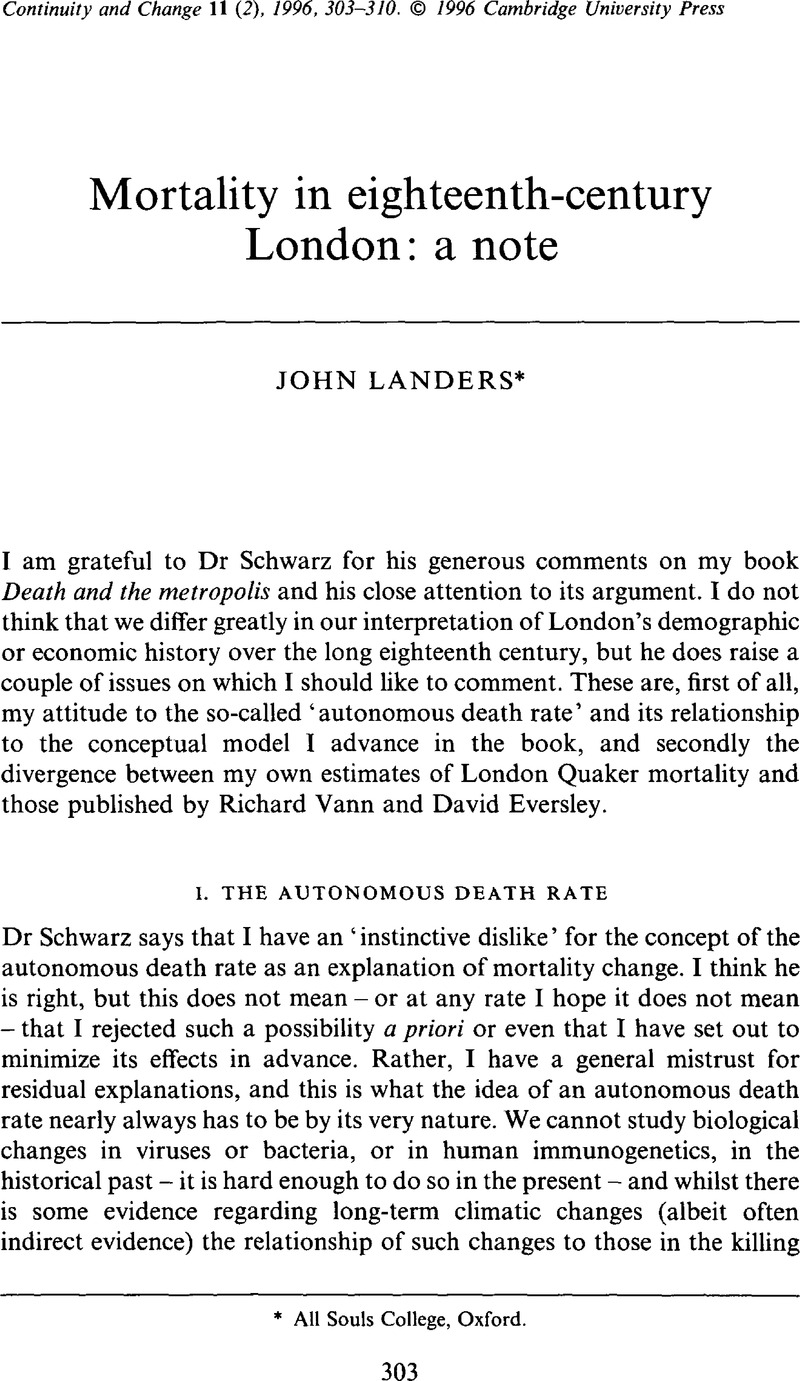No CrossRef data available.
Article contents
Mortality in eighteenth-century London: a note
Published online by Cambridge University Press: 11 November 2008
Abstract

- Type
- Review Article
- Information
- Copyright
- Copyright © Cambridge University Press 1996
References
ENDNOTES
1 The problem of the residual explanation arises in connection with McKeown's nutritional theory of mortality decline and has received some discussion in this context (see Szreter, S., ‘The importance of social intervention in Britain's mortality decline c1850–1914: a re-interpretation of the role of public health’, Social History of Medicine 1 (1988)CrossRefGoogle Scholar. It should be noted that McKeown, who took nutrition as the residual explanation, sought positive evidence for changes in pathogenic virulence in the century after 1850 and found very little (see McKeown, T. R. and Record, R. G., ‘Reasons for the decline of mortality in England and Wales during the nineteenth century’. Population Studies 16 (1962)CrossRefGoogle Scholar).
2 The important of this distinction can be seen in such cases as the densely populated areas of pre-Columbian America where mortality potential was evidently high, but a light pathogenic load – a reflection of the evolutionary history of the population — meant that realized mortality was apparently relatively low until the introduction of pathogens from the Old World.
3 For an extended account of Dobson's interpretation of English mortality change, see her forthcoming Contours of death (Cambridge University Press)Google Scholar. Steve Kunitz' argument for the importance of spatial structure in the understanding of mortality decline is also relevant in this context (see Kunitz, S. J., ‘Speculations on the European mortality decline’, Economic History Review (2nd ser.) 36 (1983).CrossRefGoogle ScholarPubMed
4 For details see Wrigley, E. A., ‘Mortality in pre-industrial England: the example of Colyton Devon over three centuries’, Daedulus 97 (1968)Google ScholarPubMed. Recently substantial advances have been made in the measurement of adult mortality from historical material, and is to be hoped that many of the existing difficulties may now be overcome. For an example see Houston, R., ‘Writers to the signet: estimates of adult mortality in Scotland from the sixteenth to the nineteenth century’, Social History of Medicine 8 (1995).CrossRefGoogle ScholarPubMed
5 For instance, their mid-point estimate of adult male life expectation at age 30 in the 1700–1749 cohort is 26.7 years and my own is 26.2. Rather confusingly their relevant table (5.12 on p. 230) is headed ‘Life expectancy at birth’ and the individual panels are labelled with five-year adult age-groups. It seems clear from the context, however, that the figures given are for adult life expectation at the opening of the age-group.
6 For a discussion of this problem, see Woods, R., ‘On the historical relationship between infant and adult mortality’, Population Studies 47 (1993)CrossRefGoogle ScholarPubMed. In the present case it is likely that the Ledermann tables (Ledermann, S., Nouvelles tables-types de mortalité, INED Travaux et Documents, 53 (Paris, 1969)Google Scholar) used by Vann and Eversley give an over-optimistic picture of mortality at older ages, and thus of life expectation at birth, relative to their own data. The table which most closely fits urban male mortality in the 1700–1749 cohort (p. 118) on my reckoning has a 0–4-year mortality probability only slightly below the observed figure (0.41 as opposed to approximately 0.44), but its implied life expectation at age 25 is 34.8 years as opposed to Vann and Eversley's mid-point estimate of only 29.6 years.
7 For a full analysis of the Peel and Southwark material and the reliability of the rates calculated from it, see the Appendix to Landers, J., ‘Some problems in the historical demography of London 1675–1825’ (unpublished Ph.D. thesis, University of Cambridge, 1984).Google Scholar
8 Wrigley, E. A., ‘Births and baptisms: the use of Anglican baptism registers as a source of information about the number of births in England before the beginning of civil registration’, Population Studies 31 (1977).CrossRefGoogle Scholar
9 See Wrigley, , ‘Births and baptisms’, for details of the method and an example of its application.Google Scholar
10 For a discussion see my Death and the metropolis, 139–41.Google Scholar
11 This explanation implies of course that vital registration in Peel and Southwark was of a higher quality than in other London meetings at this time. This should not come as too much of a surprise as the two meetings were initially selected for study because their record-keeping was believed to be particularly good.
12 For details see Landers, , ‘Some problems’, pp. 150–1.Google Scholar


